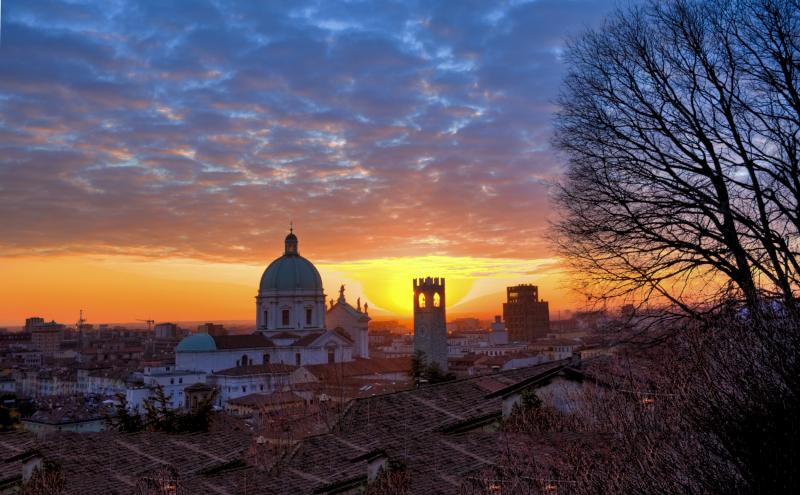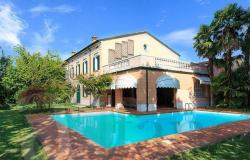Carol King heads off the beaten track to take a trip round the northern Italian city of Brescia.
Brescia is not as popular a tourist destination as the neighbouring cities of Verona and Vicenza but is equally worth visiting. Easily accessible by plane from the airports of Brescia, Verona, Milan and Bergamo, Brescia is somewhere you can visit for a weekend and see enough to enjoy the experience.
The historic centre is attractive: the sloping roofs and balconies of many of the buildings are reminiscent of an Alpine town in Switzerland. However, Brescia is Italian – it offers all the style you would expect from a country known for its rich history and artistic flair. The historic centre’s narrow streets give way to large squares flanked by porticoes packed with restaurants, cafés, bars and shops, making it a pleasant place for a stroll, peeking through intricate large wrought-iron gates that shield courtyards housing fountains and statues.

The city is known as the Lioness of Italy (Leonessa d'Italia) after ten days of popular uprising against Austrian rule during the Spring of 1849. It was founded by the Romans, and later occupied by the Lombards and Venetians, all of whom have left their mark in magnificent buildings. In Roman times, Brescia was known as ‘Brexia’. What was a Roman road that led to Milan, and is now the Via Musei, is marked by characteristic Roman straightness. At one end lies what was the political, legal and business centre, the Forum, although little remains of what must have been the bustling heart of local civic activity. Bordering the Forum, is what was once the epicentre of religious life, the Capitolium (Capitoline Temple).

Emperor Titus Flavius Vespasian built the Capitoline Temple c. 73AD as part of a public-works programme attempting to restore the empire to its former glory after years of civil war. Unfortunately, a fire swept through the city 300 years later destroying much of the area. In the 19th century, the archaeological site was home to a restaurant and diners ate off what later was identified as the capital of a temple column. The contemporary hunger for excavating classical ruins meant archaeologists begin to investigate. In 1939, experts reassembled the Capitoline Temple from what was left of its brilliant white marble structure, filling any gaps with red brick and cement. The result is a credible recreation of what must have been a dramatic building fronted by towering columns. Behind the columns lies the entrance to four cellae, the rectangular inner chambers dedicated to the ancients’ deities, complete with frescoes. To the east lies what was an amphitheatre large enough to accommodate 15,000 spectators. In the summer, the site comes alive when the temple is used to stage theatrical productions and even if you do not understand what the actors are saying, watching a play is enjoyable given the artfully lit dramatic backdrop of an ancient place of worship.

The statuary, pottery and glassware retrieved from the archaeological site are on display at the Santa Giulia Museum nearby. A visit to the museum complex offers a range of exhibits from Roman to Renaissance times. The museum is built on the ruins of the Domus, which consists of some impressive Roman town houses. The complex encompasses the Lombard church of San Salvatore and its crypt, the Romanesque Santa Maria in Solario, and the 16th-century church of Santa Giulia with its Nuns’ Choir and Benedictine monastery cloisters.
The Roman town houses were occupied from the 100AD to 400AD.

When Brescia came under Lombard rule, the area became part of the monastery’s fruit and vegetable garden. The houses are in superb condition with floor mosaics, frescoes and even an intact suspended ceiling. The museum’s curators have done an excellent job of explaining how the houses were using films and graphics detailing how wealthy Romans lived. The museum is rich in objects from Roman times, and the star piece is a large, elegant bronze statue dating back to 100AD, the ‘Winged Victory’.
The early medieval church of San Salvatore once housed the remains of Santa Giulia and its walls are covered with frescoes. The upper floor of the neighbouring church of Santa Maria in Solario has a breathtaking octagonal vaulted ceiling painted with stars. Underneath lies the 9th-century Cross of King Desiderius, which is studded on two sides with 212 precious stones, as well as exquisite cameos and glass-paste ornaments. The Nuns’ Choir is another joy and its floor-to-ceiling Renaissance frescoes depict the theme of salvation.

Of Brescia’s numerous churches, the Duomo Vecchio (Old Cathedral), on the Piazza Paolo VI stands out. Built in the 11th century, it is remarkable for its circular shape that was unusual in medieval times. The nearby Piazza della Loggia was constructed by the Venetians in the 15th century.

It houses the Torre dell’Orologio (clock tower) with a gleaming astronomical clock flanked by moving statues that ring the hours. The Renaissance square is the site of the 13th-century Broletto civic offices, capped by the Torre del Pegol (Tower of Pegol), which was once a focal meeting point and the sound of its bells used to summon citizens.
Northeast of the city on top of Mount Cidneo, Brescia Castle dominates the city’s skyline. Its views across to the city below, the Alps and the Po Valley in the distance mean it has been dubbed ‘Il Falco d’Italia’ (The Falcon of Italy), and on a clear day it’s possible to see as far west as Milan. Originally the site of a Roman temple, it was later home to a Christian church, although all that remains of the latter is the Romanesque Mirabella Tower. A fort first appeared there during the Middle Ages. The powerful Visconti family began its expansion in the 14th century by creating a circular fortress, known as the Mastio Visconteo. At the end of the 16th century, when the city was part of the Venetian Republic, a drawbridge and moat were added, and the Venetian symbol of a lion is carved in stone above the main gate.

Given the great strategic position of the castle, it is unsurprising that it has witnessed sieges between rival Italian noble families and invading French troops. The last battle took place there during the Risorgimento and saw Brescia’s brave citizens earn their place in history when they fought against Austrian forces that took refuge in the castle. The locals lost, but the battle of the Ten Days of Brescia meant the city was immortalised as the ‘Leonessa d’Italia’ (Italian Lioness) first by the poet Aleardo Aleardi and later by Noble Prize winner Giosuè Carducci. In a nod to its bloody history, the castle is now home to the Luigi Marzoli Arms Museum, which contains more than 6,000 pieces.
Brescia Castle is not just of historical interest; its slopes are home to the largest urban vineyard in the world, which produces Pusterla Bianco wine. The castle’s impressive façade with its glistening white stone keep, fairytale tower, massive ramparts and drawbridge all make it a pleasant place to take a stroll or have a picnic, finishing off by admiring the spectacular view from the shady garden at the summit.
The city’s location near Lakes Iseo and Garda makes Brescia an ideal stopover on a tour of the Italian Lakes, or a base to explore nearby sites such as the wacky Vittoriale degli Italiani (The Shrine of Italian Victories) and picturesque Franciacorta wine region.

The city hosts numerous cultural events, the most famous being the Mille Miglia classic-car rally held in May. However, whatever time of year you visit, I think it is likely you would be pleasantly surprised by Brescia.









